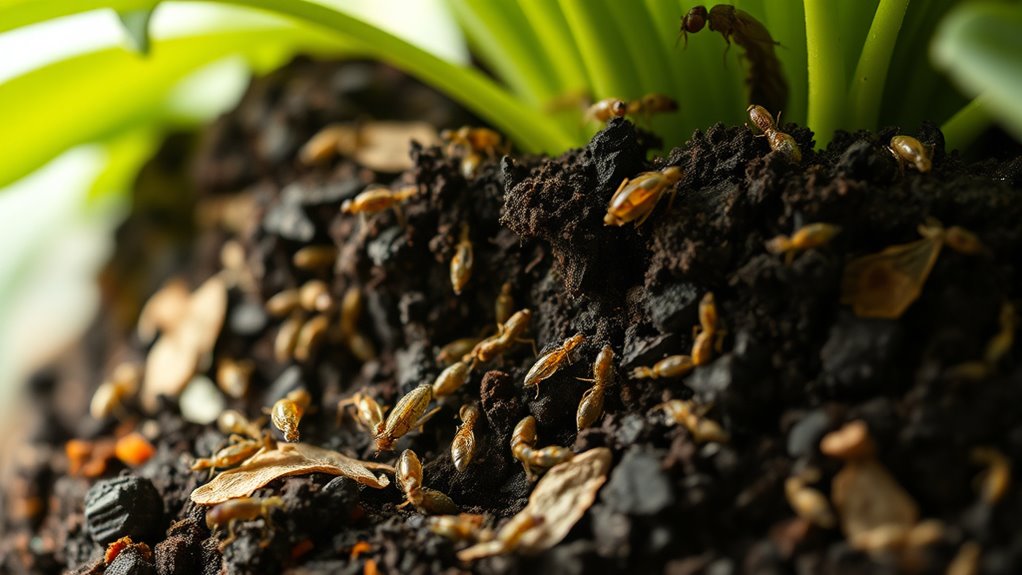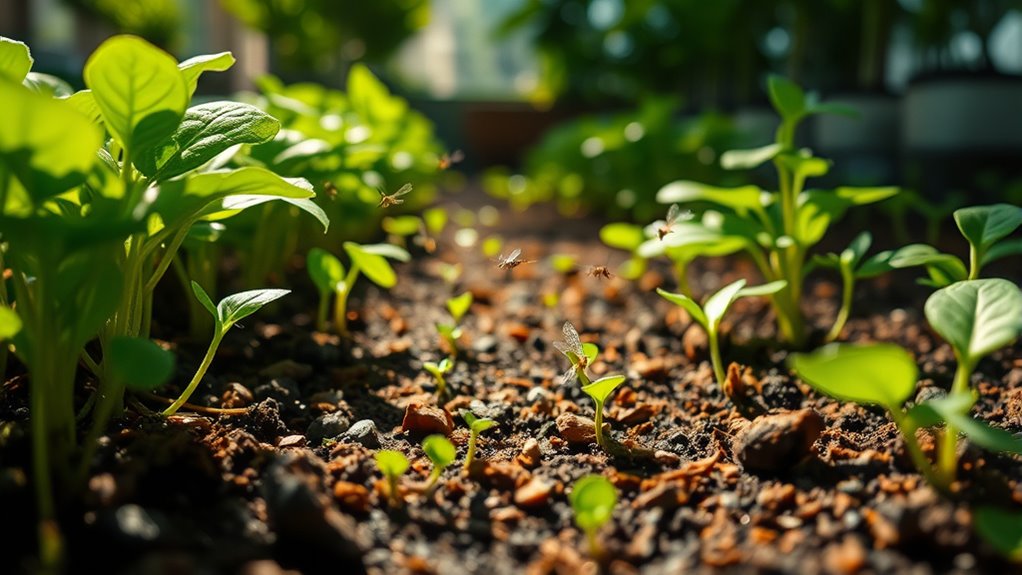To banish fungus gnats for good, combine environmental tweaks, such as letting the topsoil dry out and improving drainage with well-draining soil mixes. Use yellow sticky traps to catch adults and swap them regularly. Introduce beneficial nematodes or Bti to target larvae safely and effectively. Maintain a clean, debris-free garden to eliminate breeding sites. By applying these science-backed methods together, you can achieve long-lasting results—learn more about the best strategies to keep these pests gone.
Key Takeaways
- Use biological controls like beneficial nematodes and Bti to target gnat larvae safely and effectively.
- Improve soil drainage and avoid overwatering to prevent moist environments conducive to gnat breeding.
- Deploy yellow sticky traps to monitor and reduce adult gnat populations consistently.
- Replenish or top-dress soil with sterile or fresh substrate to eliminate existing larvae and eggs.
- Combine cultural, physical, and biological methods for sustainable, long-term fungus gnat management.

Fungus gnats can quickly become a nuisance for indoor and outdoor plants, but with the right control methods, you can keep their populations in check. These tiny insects thrive in moist, organic-rich soil, where their larvae feed on decaying plant material and roots. If you notice small black flies hovering around your plants or soil that seems perpetually damp, it’s time to act. Start by evaluating your watering habits—overwatering creates the perfect environment for fungus gnats to breed. Allow the top inch of soil to dry out between waterings; this helps reduce larval survival because most larvae need moist conditions to thrive.
Fungus gnats thrive in moist soil; let the top inch dry out to reduce larvae.
Next, consider improving your soil drainage. If water tends to pool or the soil stays wet for long periods, you might need to repot your plants in well-draining potting mix or add sand or perlite to enhance aeration. Better drainage not only discourages gnats but also promotes healthier roots. You can also place yellow sticky traps near your plants to catch adult gnats. These traps are inexpensive and effective at reducing the adult population, preventing them from laying more eggs. Regularly replacing traps ensures a steady decline in gnat numbers.
Introducing biological controls is another science-backed method that works. Beneficial nematodes, such as Steinernema feltiae, are microscopic worms that hunt down and kill gnat larvae in the soil. You can purchase these nematodes and apply them according to instructions—usually watering them into the soil. They’re safe for plants, pets, and humans, and they provide ongoing suppression of gnat larvae. Additionally, you might consider using Bacillus thuringiensis israelensis (Bti), a naturally occurring bacteria that targets gnat larvae when applied to the soil. Both biological controls are effective and eco-friendly solutions that break the gnat life cycle at the larval stage.
Furthermore, understanding the IRA investment strategy can help you allocate resources efficiently, similar to how choosing the right biological controls ensures long-term suppression of pests. Another approach is to replace or top-dress your soil with sterile or fresh soil, especially if your current substrate is heavily infested. This removes existing larvae and eggs, giving your plants a fresh start. If you’re dealing with outdoor plants, keep your garden free of fallen leaves and organic debris that can serve as breeding sites. Mulching with coarse materials like gravel or sand can also deter adult gnats from laying eggs in the soil surface.
Frequently Asked Questions
Are Fungus Gnats Harmful to Humans or Pets?
Fungus gnats aren’t harmful to humans or pets directly, but they can be a nuisance and may indicate overwatering or excess moisture. Their larvae can damage plant roots, which might lead to plant decline. While they don’t bite or transmit diseases, having many gnats indoors can cause discomfort. To keep everyone safe, focus on reducing excess moisture and using effective controls. This way, you protect your plants and maintain a comfortable, pest-free environment.
How Long Does It Take to See Results After Treatment?
Think of your garden as a battleground, and your treatment as the rallying call. Usually, you’ll see results within a week or two, as the treatment works to eliminate larvae and adults. Patience is key; you might need multiple applications. Keep monitoring and continue treatments as recommended. With persistence, you’ll reclaim your space from these pests, turning the fight into a victory that’s both rewarding and lasting.
Can Fungus Gnats Infest Outdoor Plants?
Yes, fungus gnats can infest outdoor plants. They’re attracted to moist soil and decaying organic matter, which are common in outdoor gardens. You might notice tiny flying gnats around your plants or see larvae in the soil. To control them, avoid overwatering and remove decaying plant material. Using biological controls like beneficial nematodes can also help, especially in outdoor settings where chemical treatments are less desirable.
Are Natural Remedies Safer Than Chemical Controls?
Think of natural remedies as gentle guardians, like a caring friend watching over your plants. They’re generally safer than chemical controls because they often use organic ingredients that pose less risk to you, your pets, and the environment. While they might require a bit more patience and consistency, they effectively target fungus gnats without the harsh side effects. So, yes, natural solutions tend to be safer and more eco-friendly for your garden.
What Are Signs of a Severe Fungus Gnat Infestation?
If you notice an abundance of tiny flying gnats around your plants, it’s a sign of a severe infestation. You might also see larvae in the soil, which look like small, white worms. Over time, the soil may become increasingly moist and develop mold or fungus. As the infestation worsens, plant roots can suffer, leading to wilting and poor growth. Act quickly to prevent further damage and control the pests.
Conclusion
So, next time fungus gnats invade, you’ve got science on your side. You’ll happily drown them with soapy water, trap them with yellow stickers, or let beneficial nematodes do the dirty work. Ironically, the tiniest pests require the simplest solutions. With these proven controls, you’ll outsmart those pesky critters faster than they can multiply—proving once again that even the smallest foes can be defeated with a little know-how. Who knew science could be so satisfying?











